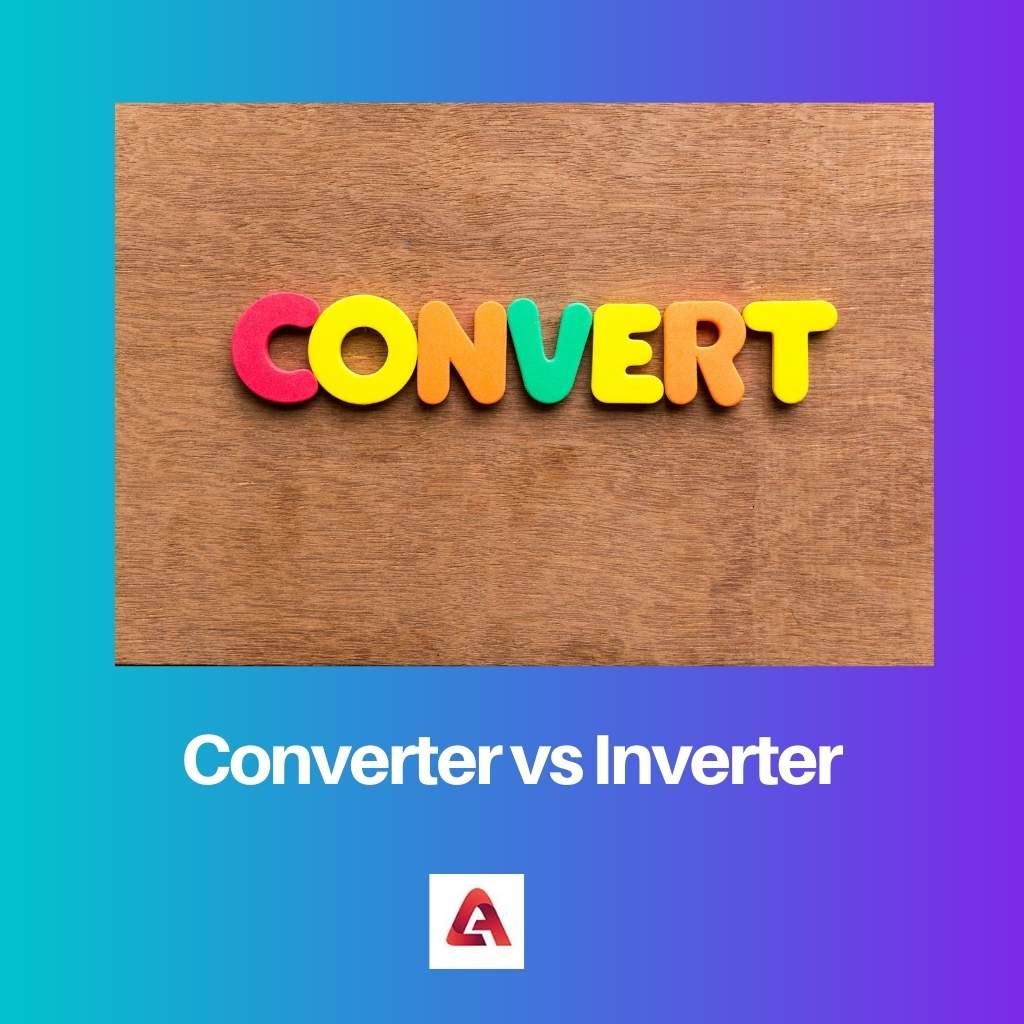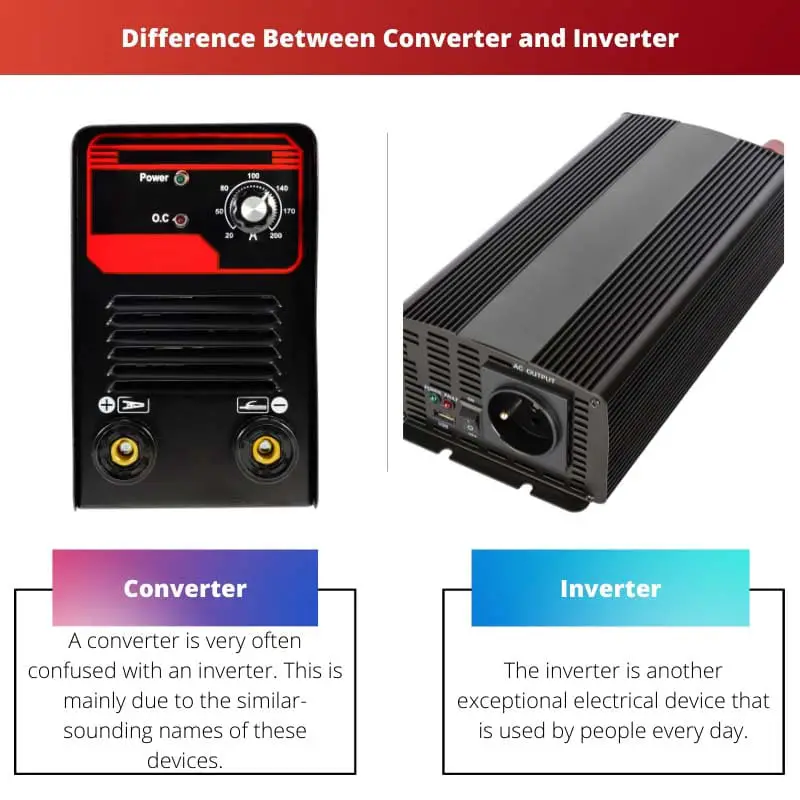Electronics and electrical engineering students may more come across these terms’ converter and inverter. Irrespective of the subject, we may even come across these terms in our lives.
People get confused between the terms’ converter and inverter. The converter is the one that converts AC energy to DC energy. On the other hand, the inverter converts the DC energy to AC energy.
Key Takeaways
- A converter is an electronic device that changes an electric current’s voltage, frequency, or phase.
- An inverter is a device that converts direct current (DC) to alternating current (AC).
- Converters are used to change one type of electrical signal to another, while inverters are used to convert DC to AC.
Converter vs Inverter
The difference between a converter and an inverter is that the converter is the one that transforms the AC voltage to DC voltage, and the inverter is the one that changes the DC voltage to the AC voltage. In other words, the Converter converts 110 voltages to 12 voltages, and the inverter modifies 12 voltages to 110 voltages.

The converter is an electrical device that involves the conversion of AC voltage to DC voltage.
The work of a converter includes obtaining the electrical energy from, let’s say, a 50 amp from a power inlet and sending it to the necessary electrical appliances such as an air conditioner or a television.
Inverter, on the other hand, involves the conversion of direct current to alternating current. It includes obtaining energy from the batteries and involves inverting the power.
Products such as mobile phone chargers operate under the process of an inverter. One should be aware that the inverter does not supply endless energy to the products.
Comparison Table
| Parameters of Comparison | Converter | Inverter |
|---|---|---|
| Meaning | It is an intermediary between the power source and supply output. | It obtains energy from batteries and powers the appliances. |
| Conversion | Alternating current to Direct current. | Direct current to alternating current. |
| Usage | It detects amplitude-modulated radio signals and supplies polarized voltage. | It is used to convert the DC voltage from batteries and solar panels. |
| Appliances | It is involved in appliances such as air conditioning. | It is involved in appliances such as mobile phone chargers and UPS. |
| Types | There are two types, half-wave rectifier, and full-wave rectifiers. | There are two types, pure sine wave inverters and modified sine wave inverters. |
What is Converter?
A converter is very confused with an inverter. This is mainly due to the similar-sounding names of these devices. A converter differs significantly concerning the work it performs and the uses of the device.
As this term is too generic, it is frequently used by people in the wrong manner.
To put it in simple terms, the main objective of a converter is the conversion of AC or alternating current to DC or direct current. This converter is an electrical machine that is used to convert the current.
This is a general and theoretical explanation of the work performed by a converter.
It can be better understood when one tries to understand the practical functions of a converter. For example, a converter obtains electrical energy of 50 amp from a power inlet.
Then it converts the alternating current it had obtained into direct current. After the conversion, the direct current is sent to electrical appliances like television and thus allows them to work.
There are two types of converters that are commonly used. They are half-wave rectifiers and full-wave rectifiers.
Half-wave rectifiers are used in appliances requiring low power and not having a uniform signal. Full-wave rectifiers are used when a steady and stable DC voltage source is required.
What is Inverter?
The inverter is another exceptional electrical device that people use daily. It is once again confused with the converter because of their similar-sounding names.
An inverter is a different electronic device that performs the conversion of current. Though the work might sound similar, there are significant underlying differences between the converter and inverter.
To explain it in layman’s terms, the main objective of an inverter is the conversion of DC or direct current to AC or alternating current. This inverter is an electrical machine that is used to convert the current.
Here is a general and theoretical explanation of the work performed by an inverter.
It can be better understood when one tries to understand the practical functions of an inverter. For example, when a house’s main power line is unavailable, the inverter provides the necessary voltage.
This can be found in UPS appliances, as they convert the DC voltage into AC voltage. The inverter provides the necessary power to keep the appliances working smoothly.
Even mobile phone chargers are operated by inverters. Two types of inverters are regularly used: Pure Sine Wave Inverters and Modified Sine Wave Inverters.
The PSW inverter produces an output of pure sine waves. The MSW inverter is used to produce an output of a modified rounded-off sine wave.
Main Differences Between Converter and Inverter
- The converter is a device that acts as an intermediary between the power source and supply output. The inverter is a device that derives power from batteries and provides it to electrical appliances.
- The converter transforms the alternating current, or AC, into a direct current or DC. The inverter transforms the direct or DC current into an alternating current or AC.
- The converter can detect amplitude-modulated radio signals and supply polarized voltage for welding. The inverter can transform the DC voltage from power sources like solar panels and batteries.
- There are two types of converters, and they are half-wave rectifiers and full-wave rectifiers. There are two types of inverters, and they are pure sine wave inverters and modified sine wave inverters.
- Converters are used in almost all electronic appliances, like air conditioning. Inverters are used in UPS devices, mobile phone chargers, and others.


“I appreciate the detailed explanation of the functions of the converter and the inverter.”
“The information about the practical functions of a converter and inverter was enlightening.”
“The comparison table is especially helpful in understanding the differences.”
“This article provides a comprehensive understanding of the differences between converters and inverters.”
“The importance of converters and inverters in our daily life is highlighted very well.”
“I found the explanation of the main differences between the converter and inverter to be exceptionally clear and informative.”
“Thank you for this informative article, it’s very useful.”
“The article does a good job explaining the differences between a converter and inverter.”
“I agree. This is a well-written explanation.”
“This article provided clear and precise information about these topics.”
“The detailed information about the main differences between converters and inverters was very educational.”
“The practical examples used in the article helped to illustrate the concepts effectively.”
“The section explaining what an inverter is was particularly interesting and well-explained.”
“This article was extremely enlightening and will be beneficial for students and individuals within the electronics and electrical engineering domain.”